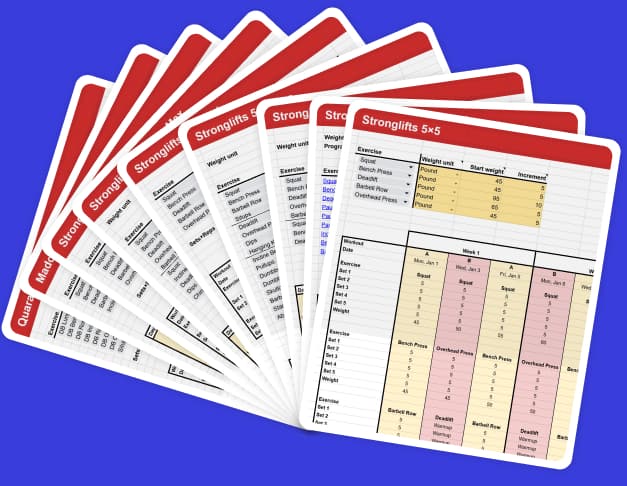You shouldn’t plateau on Madcow 5×5 for 8-12 weeks if you pick your starting weights correctly.
When you do eventually plateau, you simply restart the program. If you plateau within six weeks, you made one of the next mistakes.
Contents
Join the Stronglifts community to get free access to all the spreadsheets for every Stronglifts program. You’ll also get daily email tips to stay motivated. Enter your email below to sign up today for free.
#1. Starting too heavy
The most common mistake is starting with too heavy weights. Starting heavy doesn’t make you stronger faster. It makes you plateau faster.
Take John. His goal is to Squat 225lb. He has done 215lb before but with no so good form. And he did that after a limited warmup, not four ramp sets of five. Yet he decides to start Madcow 5×5 with 210lb.
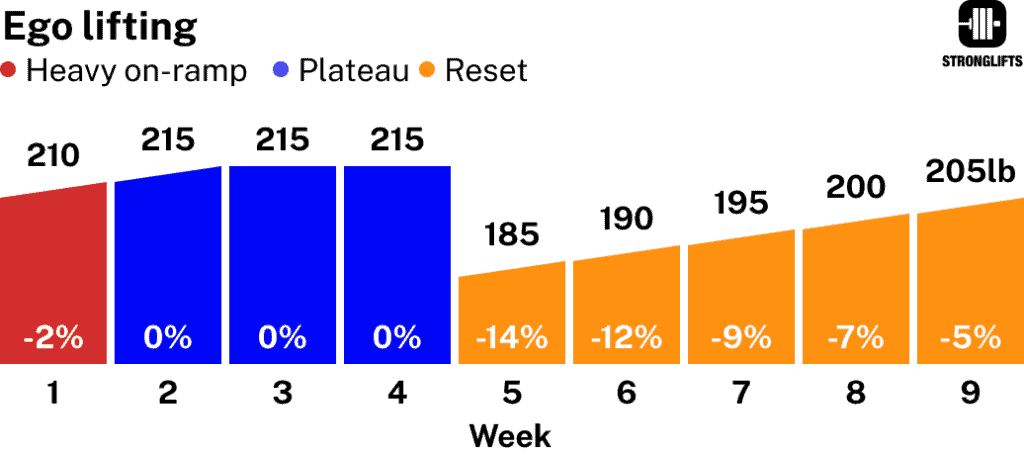
John barely completes all sets the first week. His legs are sore for days so he skips workout B. In week two he fails with 215lb. His legs are still sore and the program feels like to much. In week four John still can’t get past 215lb. He realizes his mistake and resets to 185lb.
Contrast that to Paul’s approach. His goal is also to Squat 225lb. He has done 215lb before. But he starts Madcow 5×5 with a lighter weight.
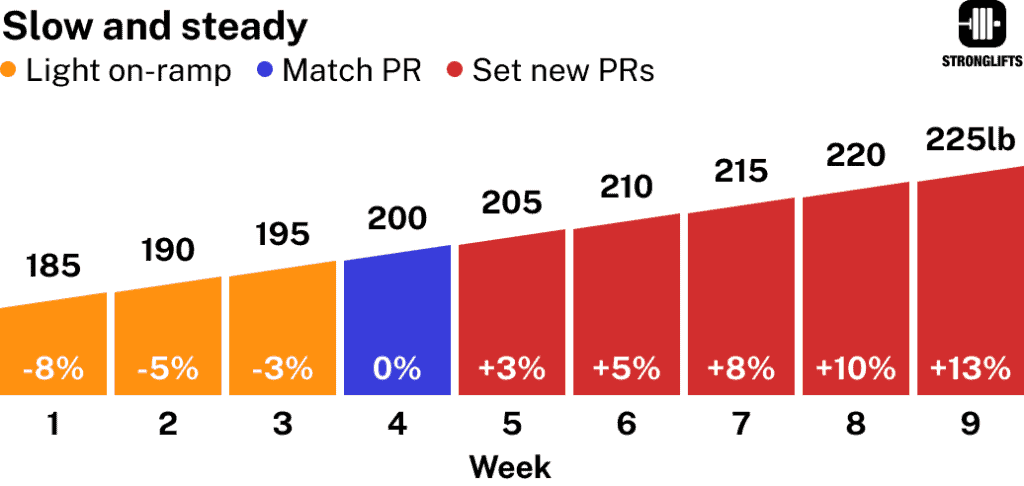
Unlike John, Paul’s legs don’t get that sore. The volume doesn’t feel too much. The workouts are a bit easy but he decides to focus on his Squat form. By week nine Paul is Squatting more than John.
Which way is better? Ego lifting or slow and steady?
Say you want a tan. If you tan for hours the first day, you’ll burn. You’ll need to skip tanning for a few days. If you start small instead and build up slowly, you can tan more often. You get darker faster.
Many people start too heavy because they’ve never trained like athletes. They usually workout until failure to get sore, pumped and tired. They’ve never done programs where you start small and do more over time.
The goal isn’t to max out the first week. The goal is to add weight every week. Starting with your max doesn’t give you room to progress. Your body has no time to adapt to the volume and frequency.
If you started too heavy on the Squat or Deadlift, lower the weight by 20% on that lift and progress from there. If you started too heavy on every lift, restart Madcow 5×5 with lighter weights.
Read: starting weights on Madcow 5×5
#2. Too short on-ramp
Madcow 5×5 defaults to a four week on-ramp. You take four weeks to hit your previous best lifts. In week five you hit new personal records.
Some people on-ramp for only 2-3 weeks. They do this to get stronger faster. This has the opposite effect. You plateau faster. Your body gets less time to adapt to the high volume and frequency.
Here’s an example of a shorter three week on-ramp. You start with 190lb but already fail at 200lb in week three. You now have to repeat that weight in week four. You lost a week of progress.
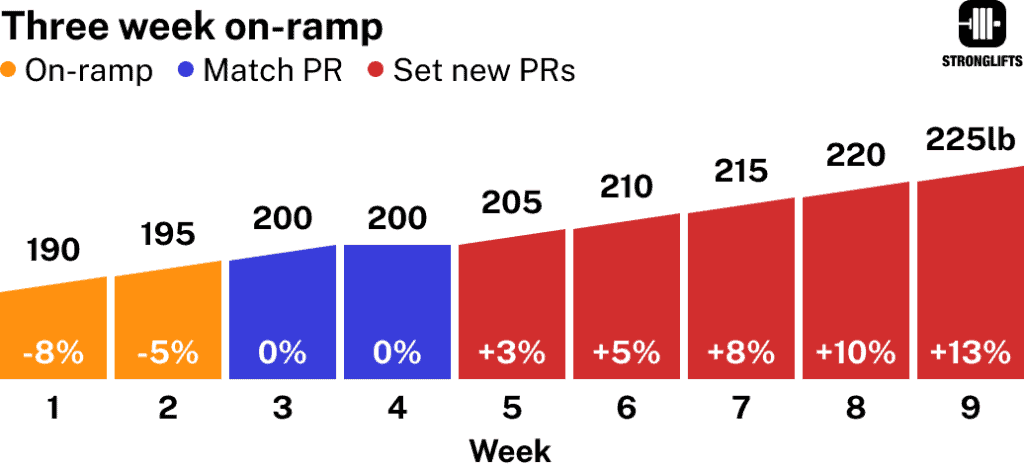
Compare that to the default four week on-ramp below. You start with 5lb less. But you don’t fail at 200lb in week four. The end-result is the same: 225lb in week nine despite starting with a lighter weight.
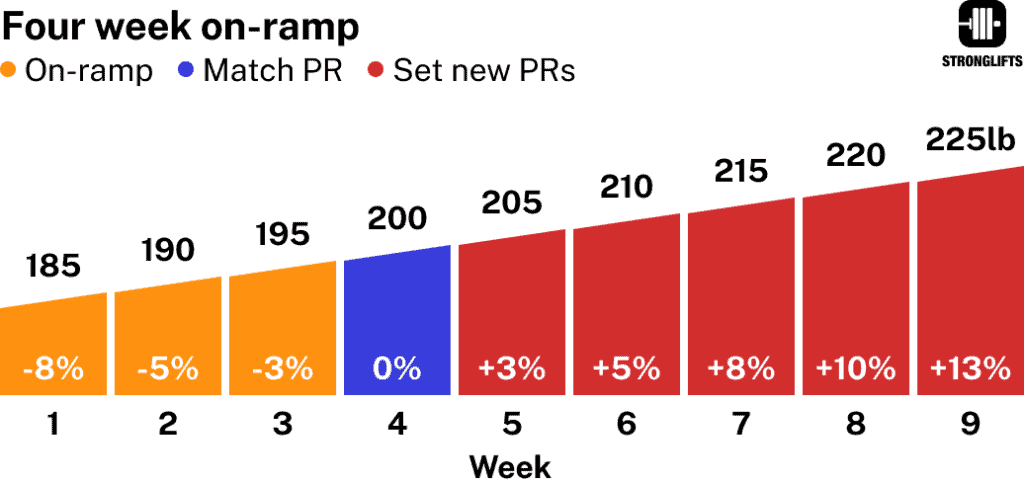
Which way is more motivating? Progressing for weeks without failing? Or failing reps in week three already? Not failing is better. And that’s what you should expect if you pick correct starting weights. You shouldn’t plateau until week 12.
In fact, Stronglifters who do Madcow 5×5 for a second time often prefer a slower on-ramp of 5-6 weeks. The first two extra weeks are lighter and act like a deload. In week 5-6 they hit their prevous bests. After that they still have several weeks to hit new personal records.
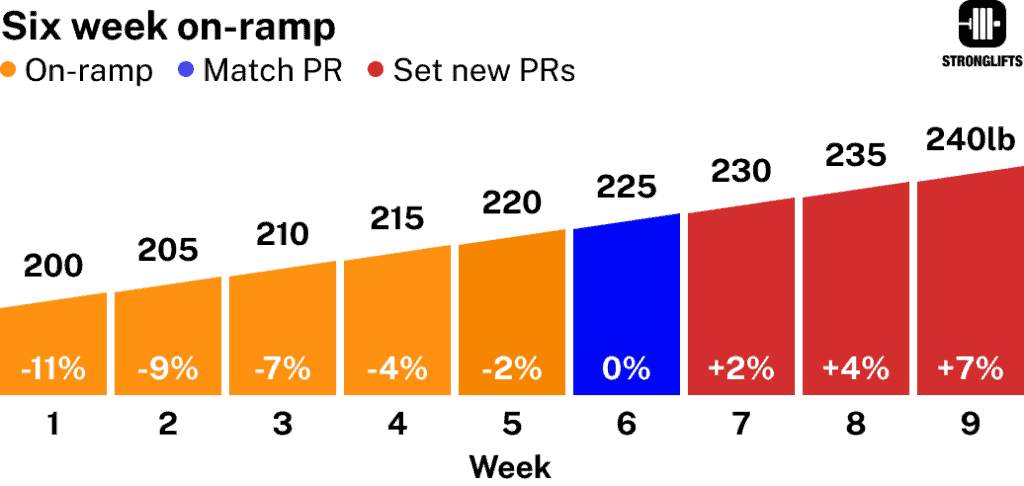
Your body will get stronger at the rate that it can get stronger. You can’t force it to get stronger faster by using a shorter on-ramp period. That usually backfires and ends up wasting time.
#3. Adding too much weight
Your goal is to add weight every week on Madcow 5×5. The bigger the weight increment you use, the more likely you’ll plateau.
Say your best Deadlift is 300lb. You add 5lb per week. From week four to week nine, your Deadlift increases by 25lb. That’s 8% more.
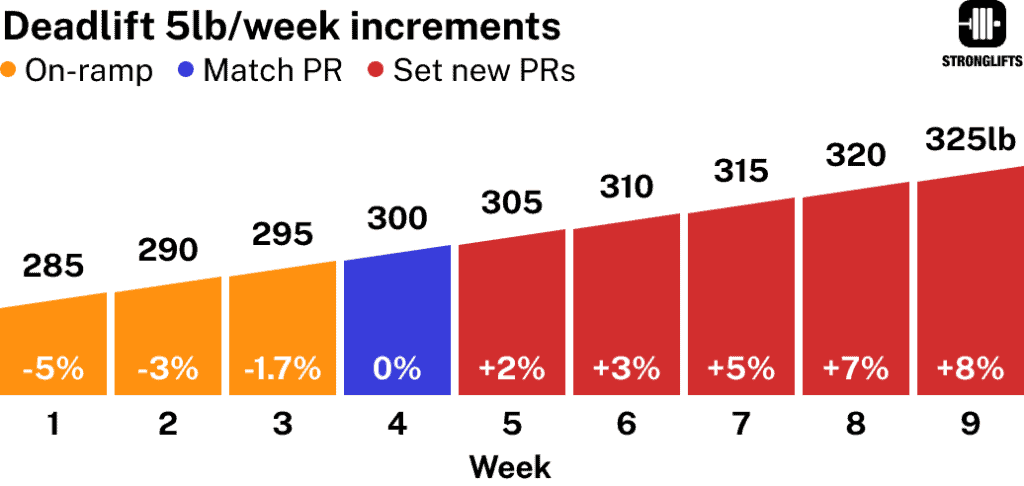
Now say you Overhead Press 110lb. You also add 5lb per week. From week four to week nine, you add 25lb on this lift too. But going from 110lb to 135lb is a 23% increase – 3x more than on Deadlifts. That’s why you’ll usually plateau sooner on the Overhead Press.
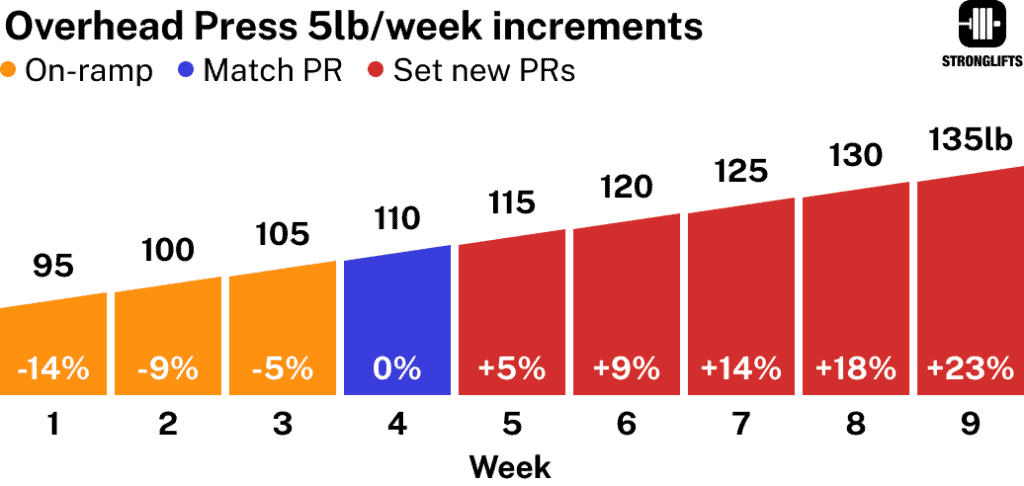
Compare that to adding 2.5lb/week on the Overhead Press. The weight now increases by 11% from week four to week nine. That’s much closer to the 8% increase on your Deadlift.
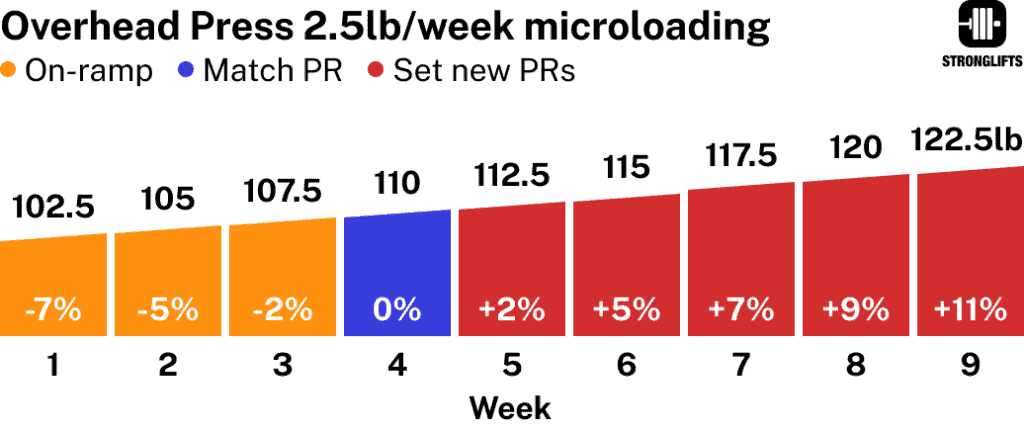
Here’s the point:
The less weight you lift, the bigger of an increase 5lb jumps are. You lift less weight on exercises that use smaller muscles. And so you need to use smaller increments on those lifts to avoid plateaus.
| Exercise | Muscles | Muscle size | Increment |
|---|---|---|---|
| Squat | Legs | Large | 5lb |
| Deadlift | Legs, back | Large | 5lb |
| Bench | Chest, shoulders, triceps | Small | 2.5lb |
| OHPress | Shoulders, triceps | Small | 2.5lb |
| Row | Back, biceps | Small | 2.5lb |
2.5lb increments means 1.25lb on each side of the bar. You need fractional plates for this. Some gyms don’t have them. Buy a pair and put them in your gym bag. They’re small and don’t take much space.
- Rogue 1lb and 0.25lb plates
- Rogue 0.5kg and 0.125kg plates
- Strength Shop – 0.5kg, 0.25kg and 0.125kg (with bag)
Many people pick increments based on what plates their gym have. Some gyms don’t even have 2.5lb plates. Adding 10lb/week will make you plateau. Pick increments that your body can handle.
#4. Pyramiding the sets
Pyramid sets is where you do less reps as you add weight on the bar. Pyramid sets make the top set easier to lift. But they lower the volume of your workouts. This can make you plateau.
The 5×5 in Madcow 5×5 means five sets of five reps. Not 5/3/2/1/5. If you drop the reps while you add weight, you’ll drop the volume too.
| Squat workout A | Pyramid sets | Ramp sets |
|---|---|---|
| Set 1 | 5×135 | 5×135 |
| Set 2 | 3×170 | 5×170 |
| Set 3 | 2×205 | 5×205 |
| Set 4 | 1×240 | 5×240 |
| Set 5 | 5×275 | 5×275 |
| Volume | 3210lb | 5125lb |
Here the pyramid sets decrease the volume by 37%. This makes the top set easier to lift. The first four sets create less fatigue. But this changes the program by making it lower volume than it should be.
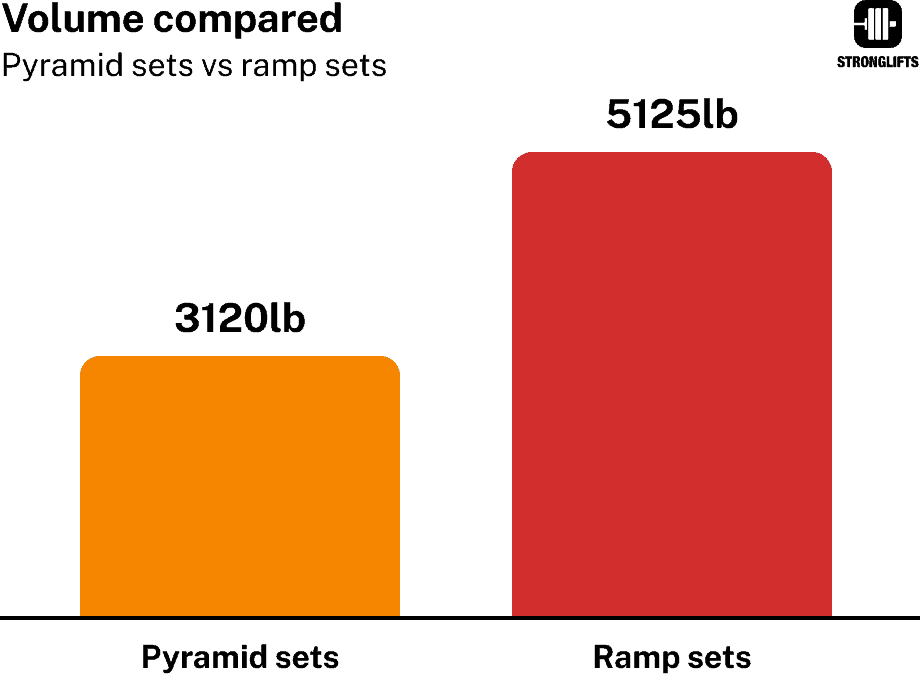
Your goal in each workout is to do several sets of five reps before your top set of the day. You could go heavier if you did pyramid sets. But your goal isn’t to test your max. Your goal is to build strength. You need some volume for that. Testing your max is for later.
That’s why you should pick easy starting weights. Say your best Squat is 5x225lb after a pyramid warmup. In week four you have to do this after four sets of five. Those 20 reps add fatigue and make 5x225lb harder to lift. If you don’t consider that, you’ll start too heavy and plateau.
The solution isn’t to pyramid the sets to make it easier. The solution is to pick easy starting weights. Let your body get used to the fatigue the ramp sets create. They add volume which you need to progress.
#5. Skipping the back off sets
In workout C you do one back off set of eight reps after doing your top set of three reps. If you skip this back off set, you’ll lower the volume of your workouts. This can make you plateau.
It gets even worse if you pyramid the sets on top of skipping the back off set. This drops your volume by 57%.
| Squat workout C | Pyramid, no back-off | Ramp sets + back off |
|---|---|---|
| Set 1 | 5×135 | 5×135 |
| Set 2 | 3×175 | 5×175 |
| Set 3 | 2×205 | 5×205 |
| Set 4 | 1×245 | 5×245 |
| Set 5 | 3×280 | 3×280 |
| Set 6 | skip | 8×205 |
| Volume | 2695lb | 6280lb |
Say you do pyramid sets in workouts A and C, and skip the back off set in workout C. The volume of these two workouts is now lower than what you should get from workout C alone.
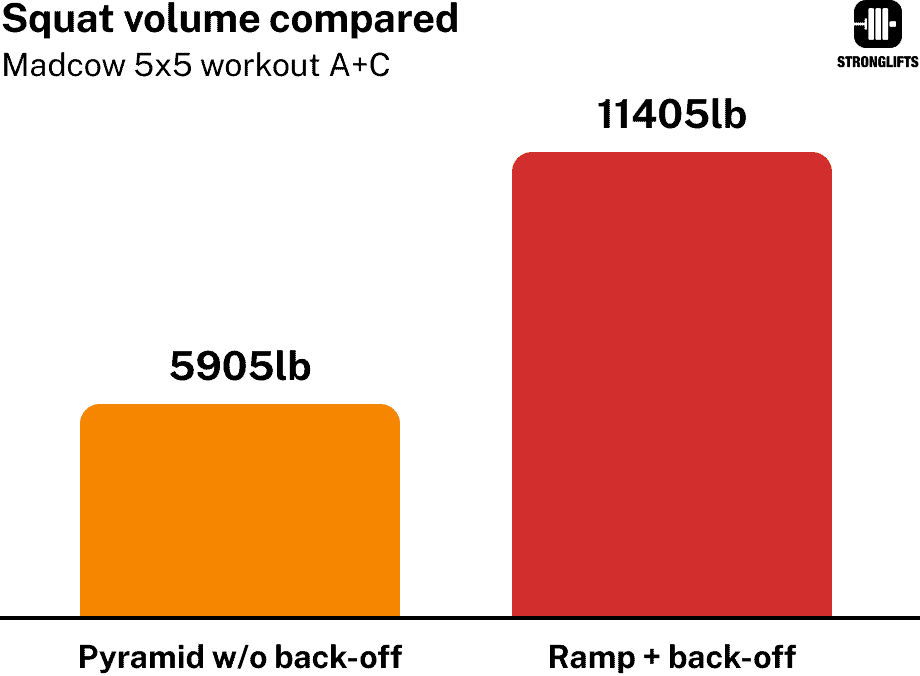
Skipping the back off sets and ramp sets turns Madcow 5×5 into a low volume program where you hit a max each workout. You’ll plateau early because the volume is too low. If the back off and ramp sets weren’t necessary to progress, they wouldn’t be in the program.
Don’t skip the back off sets in workout C. If you skip them because the workout is too hard to complete, you started Madcow 5×5 too heavy.
#6. Resting too little between sets
Your body uses your ATP-CP energy system to lift weights. Your energy stores empty with each set. If you start your next set before they’re restored, you’re more likely to miss reps and plateau.
Willardson et al compared one, two and five minutes rest on Squats (1). Longer rest times resulted in more reps done per set.
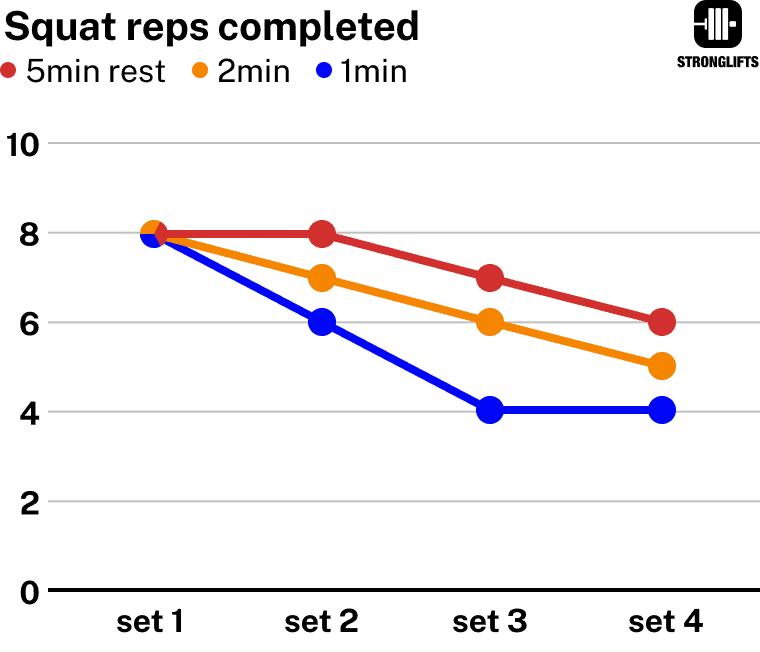
The same thing happened on the Bench Press. Resting five minutes between sets resulted in more reps done per set.
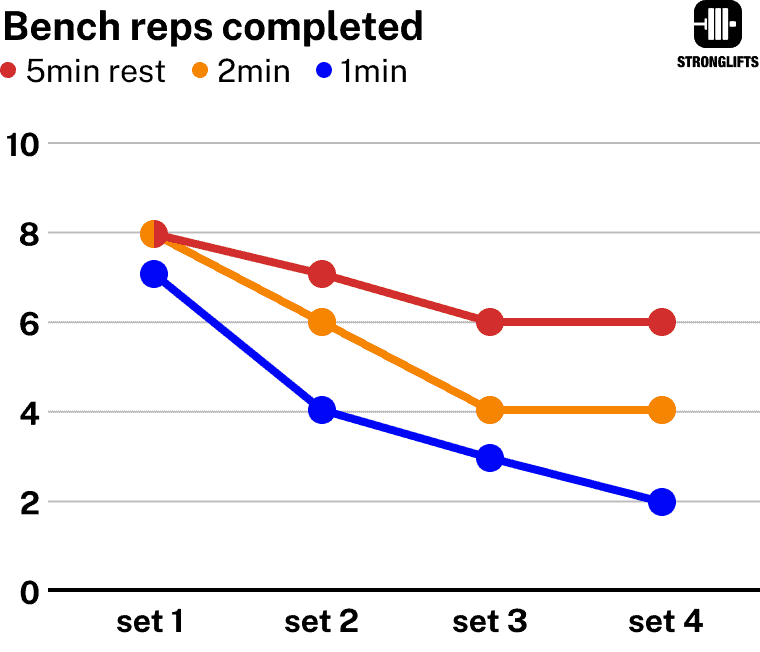
The problem is that longer rest times increase gym time. Many people don’t have much time to exercise (2, 3, 4) . But you don’t need 5min rest on every set. You only need to rest longer before your hardest sets.
Example for Madcow 5×5 workout C:

Here’s how this works:
- Set 1-3: 1min rest because they’re light. Add weight and go.
- Set 4: 3min rest before your heaviest set of five of the day.
- Set 5: 5min rest before your top set of three of the day.
- Set 6: 3min rest because this isn’t a drop set.
If you rest 5min between every workset, you spend an extra 12min per exercise. That’s almost 40 minutes per workout. But there’s no need to rest 5min before easier sets. Do that on hard sets only.
Rest longer if you expect the next set to be hard. If last week was hard, rest up to 5min before doing that set this week. You’re more likely to complete the set and progress instead of plateauing.
#7. Using too small set intervals
Your set intervals determine the weight jumps between the ramp sets. Smaller set intervals decrease the weight jumps. This creates more fatigue and can make you plateau.
Compare how heavy each ramp set is when you use bigger set intervals of 15% vs smaller ones of 5%…
| Set intervals | 15% | 5% |
|---|---|---|
| Set 1 | 5×110lb | 5×220lb |
| Set 2 | 5×150lb | 5×235lb |
| Set 3 | 5×190lb | 5×245lb |
| Set 4 | 5×235lb | 5×260lb |
| Set 5 | 5×275lb | 5×275lb |
| Volume | 4800lb | 6175lb |
You’re doing four sets with 235lb or more when using 5% set intervals. These heavier sets create more fatigue and add volume.
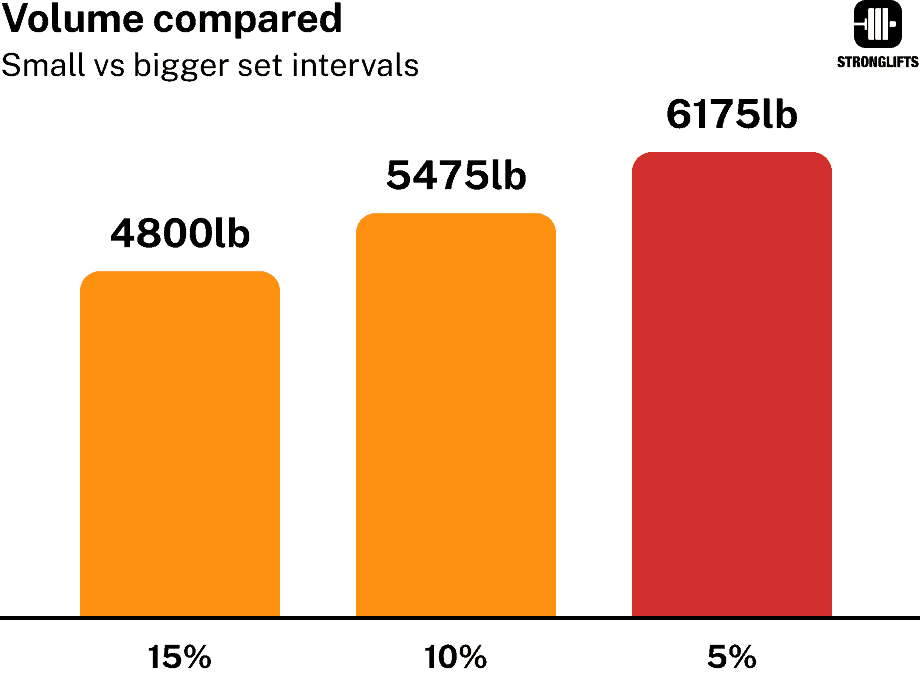
The volume is 27% higher with 5% set intervals compared to 15% set intervals. The extra fatigue this creates makes the top set harder to complete. It can make you miss reps and plateau.
Most people should stick to the default set interval of 12.5%. This adds enough volume to progress without creating too much fatigue.
#8. Not putting in enough effort
Effort is how many reps you do compared to how many you could do. Say you could do five reps if you went all out. But you only did three. Your effort wasn’t 100%. Now say that you need 90% effort to Squat 275lb for five reps. If you only apply 80% effort, you’ll fail to lift the weight for five reps and plateau.
Most people are quick to look for a “better program” when they plateau. They don’t realize that they can make the same program better by finding ways to put in more effort into each workout.
Effort has been called one of the “forgotten variables” for optimizing strength and muscle gains (5). Gentil et al found that people under higher supervision trained at a higher intensity (6). They gained more strength on the Bench Press because they worked harder.
Here’s how you can put in more effort:
- Squat and Bench in the Power Rack. Many people stop hard sets early because they’re afraid to get stuck under the weight. Set the safeties so they can catch the bar if you fail. You’ll be able to put in more effort into each set and progress better.
- Engage more muscles. Don’t just lie on the bench. Squeeze your shoulder-blades, grip the bar hard, take a big breath to increase pressure in your torso, push yourself into the bench using your legs, etc. This takes more effort but you’ll bench more reps.
- Push/pull harder. Apply more force to the bar on the heavier sets. Try to move the weight faster. Maintain good form while you do this. Applying more force takes more effort but if you do it right, the same weight will feel easier than before.
If you never did sports before lifting (like me), you may need someone to show you how to put in more effort. Find an experienced training partner. They can push you to train harder. This is how I learned when I started lifting. My mentor kept telling me I had more reps in me. This taught me that I could do more than I thought.
#9. Doing the program for too long
You’re supposed to plateau on Madcow 5×5. You’re supposed to do the program as long as you can add weight. Once you’ve hit a plateau on several exercises, reset the program and start again.
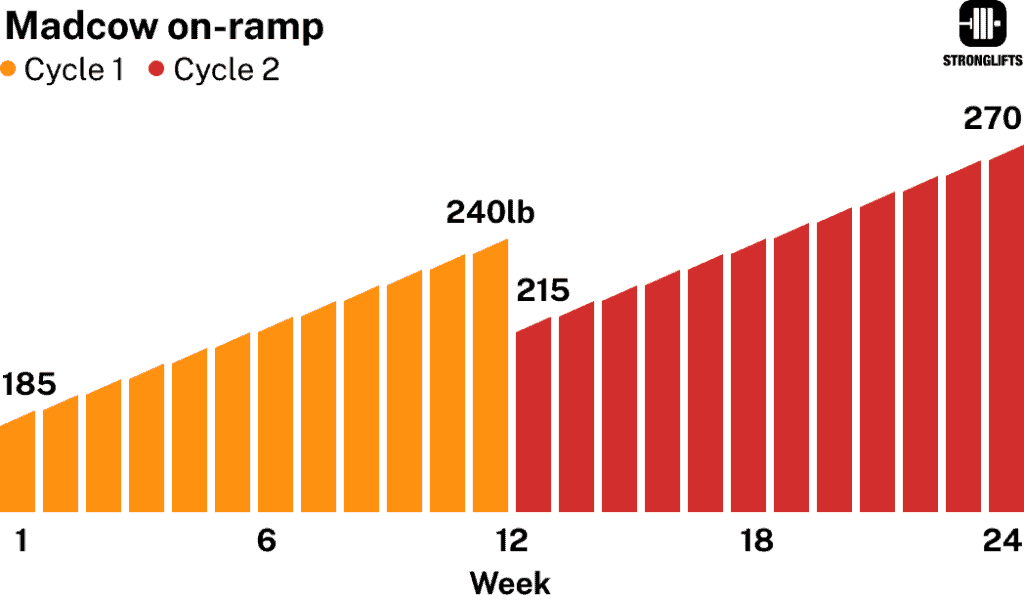
Say you’ve done Madcow 5×5 for eleven weeks. You’ve stalled on Bench and are struggling on Squats. This is normal. You can’t add weight every week forever. Otherwise everyone would Squat 1000lb.
What if you’ve plateaued on the Bench Press but are still progressing on the Squat and Deadlift? Reset Bench only. Say you’re stuck at 200lb. Reset to 190lb and add 2.5lb/week. That gives you five more weeks to progress on the Squat and Deadlift.
When you start Madcow 5×5 again change some exercises. Fonseca et al found that changing exercises was more effective than changing sets and reps for getting stronger (7). Try Front Squats and Incline Bench in workout B instead of light Squats and Overhead Press.
Or switch to Stronglifts 5×5 Intermediate.
Join the Stronglifts community to get free access to all the spreadsheets for every Stronglifts program. You’ll also get daily email tips to stay motivated. Enter your email below to sign up today for free.
References
1. Willardson, Jeffrey M, and Lee N Burkett. “A comparison of 3 different rest intervals on the exercise volume completed during a workout.” Journal of strength and conditioning research vol. 19,1 (2005): 23-6.
2. Booth, M L et al. “Physical activity preferences, preferred sources of assistance, and perceived barriers to increased activity among physically inactive Australians.” Preventive medicine vol. 26,1 (1997): 131-7.
3. Trost, Stewart G et al. “Correlates of adults’ participation in physical activity: review and update.” Medicine and science in sports and exercise vol. 34,12 (2002): 1996-2001.
4. Silliman, K., K. Rodas-Fortier, and M. Neyman. “Survey of Dietary and Exercise Habits and Perceived Barriers to Following a Healthy Lifestyle in a College Population”. Californian Journal of Health Promotion, Vol. 2, no. 2, June 2004, pp. 10-19.
5. Fisher, James P., et al. “Periodization for Optimizing Strength and Hypertrophy; the Forgotten Variables.” Journal of
Trainology, , 2018, Volume 7, Issue 1, Pages 10-15.
6. Gentil, Paulo, and Martim Bottaro. “Influence of supervision ratio on muscle adaptations to resistance training in nontrained subjects.” Journal of strength and conditioning research vol. 24,3 (2010): 639-43.
7. Fonseca, Rodrigo M et al. “Changes in exercises are more effective than in loading schemes to improve muscle strength.” Journal of strength and conditioning research vol. 28,11 (2014): 3085-92.




